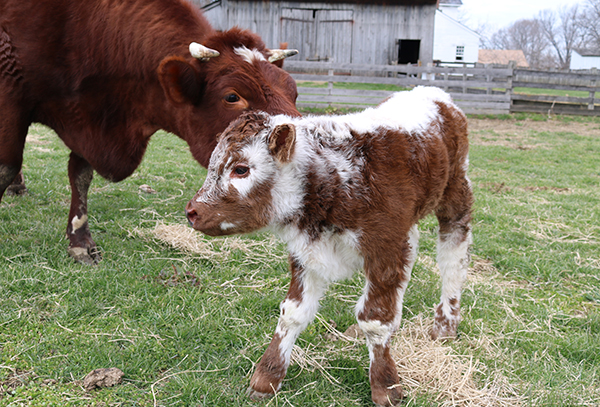An embryo transfer English Longhorn calf was born at Conner Prairie Wednesday – the first birth of its kind in decades.
The calf is now one of 11 English Longhorns at Conner Prairie, which has the second-largest herd of the breed in the U.S. There are only about 40 English Longhorns in the country.
The 7-day-old embryo was shipped from England in liquid nitrogen to keep it cold and implanted into one of the museum’s Shorthorn cows at an offsite facility nine months ago. The embryo came from Blackbrook Longhorns, a facility located in the United Kingdom operated by John and Pat Stanley.
“This is the only time it’s been done (with English Longhorns) in the United States since 1993,” said Conner Prairie Livestock Manager Kevyn Miller. “Blackbrook Longhorns have been instrumental in helping promote and preserve the breed.”
The calf born at Conner Prairie is a bull. Miller said plans are to breed the bull to English Longhorn cows at the museum to diversify the genetics of the herd.
“We’ve got two different genetic lines now,” Miller said. “We can keep breeding for several generations without inbreeding.”
English Longhorn cattle are historically accurate to the 19th century. The breed also has several traits that would be lost forever should the breed go extinct. Those traits include lean and tender meat, a gentle disposition, exceptional mothering by cows and intelligence that’s superior to other breeds.
This is the first time Conner Prairie has used embryo transfer technology. Miller said it could prove instrumental in preserving English Longhorns in the U.S.
“This is a new technology to save a really, really old breed,” he said.
Spanning nearly 1,000 wooded acres in central Indiana, Conner Prairie welcomes nearly 400,000 visitors of all ages annually. As Indiana’s first Smithsonian Institute affiliate, Conner Prairie offers various outdoor, historically themed destinations and indoor experiential learning spaces that combine history and art with science, technology, engineering and math to offer an authentic look into history that shapes society today.

